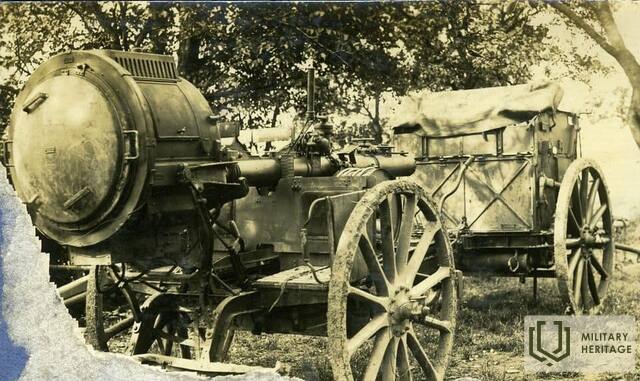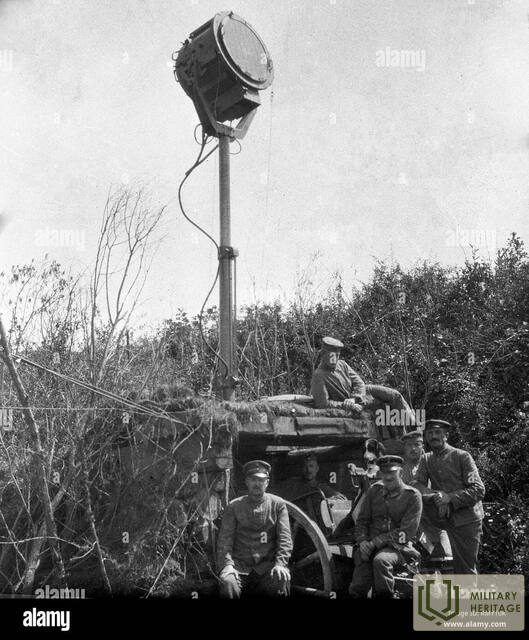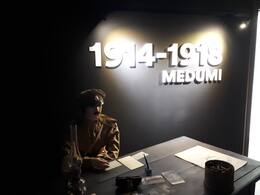Spotlight decoration in Medumos
In the autumn of 1915, the front line stabilized. The positions of the Russian Imperial Army passed through Medumi. The 250th searchlight division of the searchlight company was also stationed in Medumi. The exact location of this division in the village of Medumi has been determined.
Searchlight units were usually located near the front line and had tasks such as lighting night battles, anti-aircraft defense, support for artillery targeting, and enemy observation and tracking. In the Russian army, a searchlight company was a numerically small unit of 30-50 people, consisting of technicians to ensure the work of the searchlights, support personnel, and infantry to defend the positions. The searchlights were mounted on wheeled platforms, the diameter of the searchlights themselves was 60-90 cm and their illumination distance was 5-7 km. The power of the searchlights could vary from 10 to 50 kW. Electricity was most often provided to them by mobile generator stations powered by liquid fuel. In general, the Russian Imperial Army was technically less developed than the armies of Western countries, and therefore searchlight units played a lesser role on the Eastern Front; the equipment was often technically outdated or difficult to maintain, which limited their effectiveness.
Information and photos prepared by the First World War Museum in Medumos.
Related objects
Cycling route no. 790 "Through World War I bunkers"
A marked cross-border route that crosses the territory of Latvia and Lithuania.
During the First World War, the “Life and Death” front line was located on the territory of Latvia and Lithuania for several years. A complex system of fortifications with trenches, bunkers and bunkers was built on both sides of it. Thousands of soldiers fought and fell here in fierce battles, as evidenced by the countless burials of fallen soldiers.
The First World War has left long-lasting scars not only in the destinies and hearts of people, but also in our land. To this day, in the forests of Medumi parish, Augšdaugava region, there are still countless concrete bunkers, gun and ammunition depots, trenches, and graves of soldiers who fought on both sides of the front, built by the Germans.
This route offers the opportunity to see several better-preserved bunkers, as well as World War I exhibitions in Medumi and Turmata (Lithuania), dedicated to the First World War. The exhibitions invite visitors to view interesting artifacts, exhibits and testimonies of the First World War. The total length of the route in both countries is approximately 85 km.
On the bike route, there is an opportunity to scan a QR code at three German army bunkers and listen to a short audio story about the history and functional use of the bunkers. The audio stories are also available on the IziTravel platform HERE . The stories can be listened to in Latvian and English.
Important! Since this is a cross-border route and crosses the territory of both Latvia and Lithuania, we remind you that each person must have an identity document, passport or ID card with them.
First World War Museum
The fiercest battles of the First World War in Latvia took place near Daugavpils in August and October 1915, in the highlands of Ilūkste and Medumi. The Germans tried to break through to Daugavpils, but the Russians – to push them back. Both sides were unsuccessful and began to build trenches, creating in depth defence positions consisting of three lines.
The First World War Museum in Medumi is dedicated to these battles. The first part of the exhibition presents the history of the vicinity of Medumi, providing testimonies that bear evidence that Medumi was a well-populated and developed area before the war. Part 2 focuses on the events of the First World War in Europe and Latvia. Here, you can learn about the lives of soldiers and the innovations that emerged during the war, as well as examine the weapons used by the German and Russian armies. In the third hall of the exhibition, visitors can put themselves in the shoes of a soldier by experiencing bunker life. In this hall, a replica of a Russian bunker has been created – a fragment of a trench with a small shelter, elements of a battlefield and dummies of soldiers. Since the wooden bunkers of the Russian Army did not survive, they have been reconstructed at the museum, while the concrete bunkers of the German Army can be seen by visiting the International route of WWI Bunkers. The hall, with the imitation of a shelter, audio and video equipment, creates an authentic atmosphere of the battlefield.








